ISSN ONLINE(2319-8753)PRINT(2347-6710)
ISSN ONLINE(2319-8753)PRINT(2347-6710)
Pankaj Dahiya1, Suman Deswal2
|
| Related article at Pubmed, Scholar Google |
Visit for more related articles at International Journal of Innovative Research in Science, Engineering and Technology
Vehicular Ad-hoc Network (VANET) is a growing technology. The vehicle (acting as mobile routers) in the network uses the wireless medium to communicate with other nodes (vehicles) in their radio range. A heterogeneous wireless network (HWN) which is hybrid network of cellular network (having access routers (AR) and Internet Service Providers (ISP) for providing communication and internet services to the VANET) and VANET. Internet Engineering Task force (IETF) purposed MIPv4/v6 (Mobile Internet Protocol -version4/6) and FMIPv6 (Fast) as mobility and handover management techniques which are standard protocols. An enhancement of FMIPv6, a handover management technique using concept of tunnelling is simulated in a VANET scenario. NS2 is the simulating tool for analysing performance of advanced FMIPv6 against standard FMIPv6 by considering the parameters like Tunnelling Performance, Handover Latency, Packet Loss, Signalling Overhead Ratio, Service Disruption Time, and Network Time
Keywords |
| VANET, HANDOVER, TUNNELING, FMIPv6, LATENCY, PACKET LOSS |
INTRODUCTION |
| Vehicular Adhoc Network (VANET) is a special type of Mobile Adhoc Network (MANET) having the communication among vehicles without depending upon any infrastructure and configuration effort and is becoming popular for intervehicular communication. An example is Fleet communication System which is a radio communication technology for adhoc network among vehicles. It depends on ULTRA TDD. [1] For achieving multihop communication, instead of using IP addresses, a location based adhoc routing protocol is used for packet forwarding. [2] |
| The heterogeneous wireless network, integrates the characteristic of the cellular network and Vehicular Ad-Hoc network. It is assumed that each Vehicular Node (VN) equips with the Mobile Router (MR) and cellular interface and Ad-Hoc interface. In VANETs, vehicles can gain short connections to the Internet by using wireless access points (AP). A significant part of the connection time is the time required for acquiring an IP address via dynamic host configuration protocol (DHCP).The vehicles can use broadband wireless technology for intelligent interaction for V2V and V2I communication.[3-5] The handover between different types of networks like wireless Local Area Network (WLAN) and cellular networks are used with IP based network. [6] They act at different layers of internet architecture and we have the following standard protocols: |
| (1) Mobile IP (base MIP or MIPv4 or MIPv6- at layer 3 (network layer of internet architecture) [7-8] |
| (2) FMIPv6 (Fast) [9] |
| (3) HMIPv6 (Hierarchical) [10-11] |
| (4) PMIPv6 (Proxy) [12] |
| (5) TCPmigrate, mSCTP, SIP [13] |
| The outline of the paper is as follows. In section II related work and literature survey of different handover techniques has been given. Section III focuses on FMIPv6 (existing) and its advancement using tunneling. Simulator and simulation setup with VANET scenario is discussed in section IV. In section V, there are simulated results and discussion i.e. comparison of advanced FMIPv6 is done with standard FMIPv6 by taking various parameters like handover latency, tunneling performance etc. Finally, concluding remarks are presented in section VI. |
RELATED WORK |
| There are many models adopted for performing the handoff and managing the mobility in the network. The advanced handover procedure of FMIPv6 by using Media Independent Handover (MIH) services was explained in [14]. A NEMO (Network Mobility) protocol was proposed for VANETs which is described in [15]. The Global Mobility Management (GMM) was proposed for handover in VANET. [16] |
| In [17], SIGMA (Seamless IP Diversity Based Generalized Mobility Architecture), which works both for IPv6 and IPv4, is proposed. The concept here used is to keep remember the old path while establishing a new path for seamless handover. |
| In [18], MMIP6, a communication protocol is proposed which integrates multihop IPv6 based vehicle into the internet. Mobile IPv6 (MIPv6) cannot be used for supporting multihop. VANET as it always needed a direct link layer connection between mobile node and gateway. [19] |
| In [20], Virtual Mobile Anchor Point (VMAP) is proposed as one of the routers located between MN and actual MAP. The handover latency is reduced while analysing with HMIPv6. |
| In [21], a new algorithm based on Enhanced Access Routers (EAR) is proposed for performing better handover process than FMIPv6 hence it is EAR-FMIPv6. This EAR performs the handoff instead of router and it will configure the mobile Care of Address (CoA) and sends the BU message. |
| In [22], an advanced FMIPv6 is proposed using Media Independent Handover (MIH) services which allow an optimized handoff by increasing the probability of its operation in predictive mode. It is done by using initiation handoff link. Event indication is used in it which helps in forwarding the packet to new access router without waiting for the announcement of attachment from FMIPv6. The access router discovery is reduced with the help of MIH [23- 24]. |
| In [25-26], the schemes reduce the effect of duplicate address detection (DAD). MIH defines a network function of the network entity called MIH-F for communicating upper and lower layer through Service Access Point (SAP). |
| In [27], a handover scheme is purposed for supporting multimedia services in Vehicular Wireless Network and Vehicular Intelligent Transportation System (V-WINET /VITS). |
| In [28], a hierarchical mobility management scheme is purposed by utilizing the concept of VMAP for reduction the signalling traffic for updating the location. The concept of virtual layer is introduced. |
| In [29], Simple Mobility Management Protocol (SMMP) is purposed which provide global seamless handover not only between homogeneous networks but also among heterogeneous wireless networks which is not provided by MMIPv6 and its enhanced versions. |
| In [30], there is a proposal of a Leader-based scheme which needs the Duplicate Address Detection (DAD) when a vehicle changes its leader in the real-time applications in VANETs. |
HANDOVER MANAGEMENT TECHNIQUE (Advanced FMIPv6) |
| Mobile IPv6 provide the internet connectivity to the mobile node (vehicle as mobile router-MR) when moving from one Access Router to another, this process is called handover. During handover, there is a period during which the mobile node is unable to send or receive packets because of link-switching delay and IP protocol operations. There is a problem of "handover latency" as a result of standard Mobile IPv6 procedures (movement detection, new Care-of Address configuration, and Binding Update). |
| The packet loss and handover latency problem of MIPv6 decreases the Quality of Service (QoS) for multimedia service application and is solved by Fast MIPv6 (FMIPv6) [9]. FMIPv6 has two handover modes: first performs handover (predictive mode) after complete establishment of the tunnel between access routers (ARs) and second is reactive mode (performs the handover without the tunnel). The handover latency, packet loss and service disruption time is high in second method which can be reduced by using the concept of tunnelling. |
| Tunneling protocol: Computer networks use a tunneling protocol when one network protocol (the delivery protocol) encapsulates a different payload protocol. By using tunneling one can (for example) carry a payload over an incompatible delivery-network, or provide a secure path through an untrusted network. IPv6 or IPv4 hosts and routers can tunnel IPv6 datagram’s over regions of IPv4 routing topology by encapsulating them within IPv4 packets. Tunneling can be used in a variety of ways: Router-to-Router, Router-to-Router, Host-to-Host, and Router -to- Host. |
| A VANET Scenario is taken in which the vehicles are moving on road and vehicle can act as mobile routers which are having the facility of internet connectivity through access routers (AR) of Internet service providers (ISP). The advances FMIPv6 protocol begins when an MN [assume each node (Vehicle) as Mobile Router (MR)] sends a message (Router Solicitation for Proxy Advertisement -RtSolPr) to its access router or to its ISP when the process of handover is about to happen i.e. when this particular is in the range of two access routers. There is a movement of vehicles from one network to the other network. |
| The mobile routers (MR) are connected with the access routers (AR) and access routers have the services of Internet Services providers (ISP) which have their own home agents (HA) connecting through correspondent node. When the handover is taking place (MR1), MR1 (undergoing handover process) has to use MR2 (which still in AR1-ISP1) for internet connectivity until handover process is not completed in AR2 (ISP-2). A new CoA (Care of Address) is configured to AR2 for MR1 and after the registration, MR1 starts receiving packet from AR2. After successful tunneling between MR2-HA1 (AR1), the second tunneling between MR1-HA2 (AR2) takes place. After the completion of tunneling process, now MR1 decide whether to stay in AR1 or start using the services of AR2. |
SIMULATION SETUP |
| NS-2 (Network Simulator) is the simulating tool which is being used for the simulation of advanced FMIPv6 by considering the various parameters. NS-2 is an open-source discrete event network simulator that supports both wired and wireless networks, including many MANET routing protocols and an implementation of the IEEE 802.11 MAC layer. [31] The Vehicles moves at maximum speed of 40-120 Kmph. Other details of the simulation area are given in the following table: |
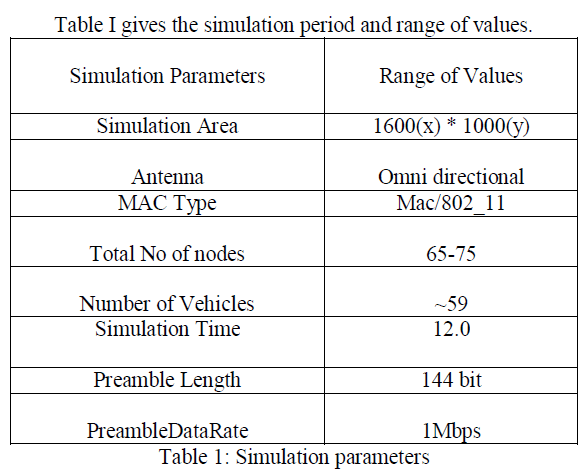 |
SIMULATION RESULT AND DISCUSSION |
| For analysing the performance of the advanced FMIPv6 with respect to the standard FMIPv6, the different parameters like Handover latency, Packet Loss, Performance Comparison using tunnelling, Service disruption time, Network Lifetime, Signalling overhead measured against time (ms, 100/10). |
| The simulation results and the performance comparison are as follows: |
| 1. Packet loss: The packet loss during the handover of mobile router (vehicle) is less for the proposed scheme as compared to the standard FMIPv6 as shown by the Figure1. As the time increases, packet loss is not increasing exponentially in the proposed scheme. The number of messages required for the handover is less in case of tunnelling mechanism as compare to the signalling messages used for handover in FMIPv6. |
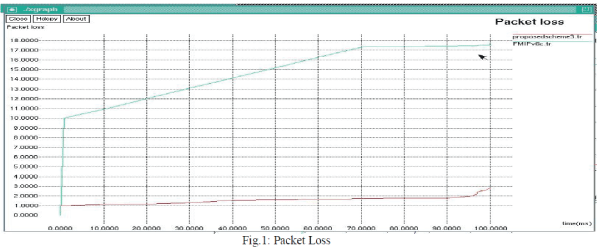 |
| 2.Handover latency: Handover latency of a mobile network is defined as the complete handover time from one access router to another access router and from the Figure2, the handover latency of proposed scheme is less as compared to the FMIPv6. |
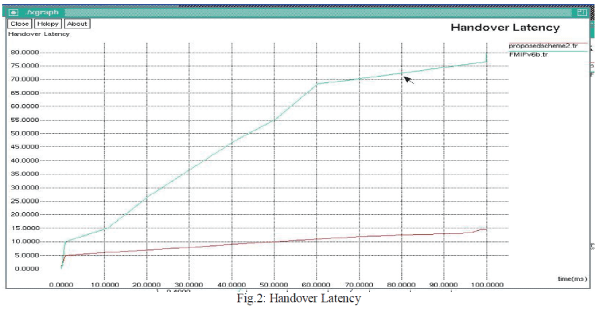 |
| 3. Service disruption time |
| The service disruption time during handover can be defined as the time between the receptions of last packet from previous access router until the first packet is received from next access router via tunnelling between them.Figure3 depict that service disruption time for the proposed scheme is less as compared to FMIPv6. |
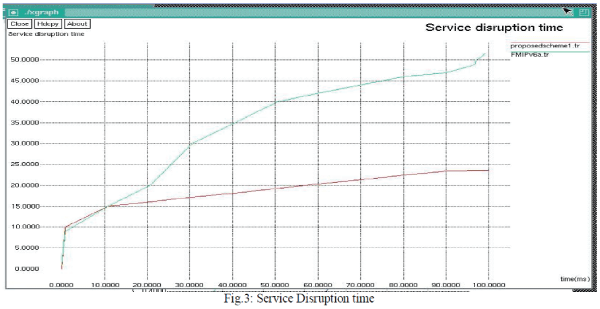 |
| 4. Network Lifetime: It is the amount of time that a network would be fully operative.The network lifetime of the proposed scheme and standard FMIPv6 is shown in the following fig (Figure4): |
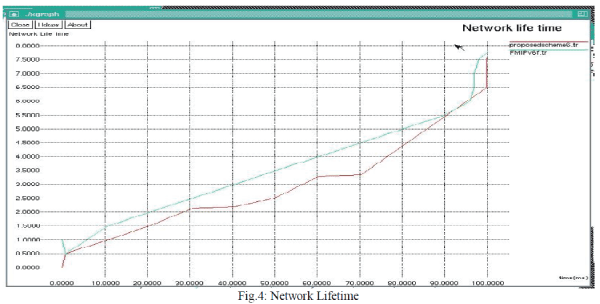 |
| 5. Signalling overhead: Signalling overhead involves the number of signalling messages exchanged to manage handover process effectively and Figure5 show that the signalling overhead of FMIPv6 is higher than standards FMIPv6. |
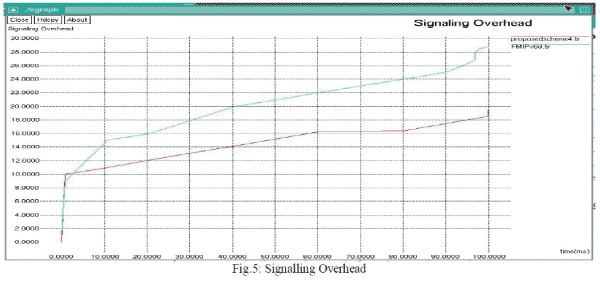 |
| 6. Performance Comparison using tunnelling The comparison of the tunnelling in the proposed scheme and FMIPv6 is done as follows i.e. the number of packets required for handover process in the proposed scheme is less as compared to the number of packets require for handover in standard FMIpv6 in Figure6. |
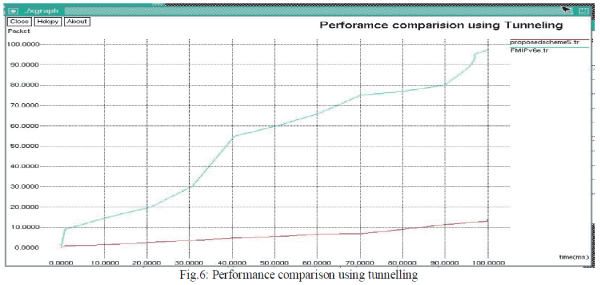 |
CONCLUSION AND FUTURE SCOPE |
| The mobility and handover management of vehicles in VANET is a broad area of research. There are various standard protocols for these techniques when each vehicle is having the internet connectivity. Various parameters like Handover latency, signalling overhead, performance comparison using tunnelling, packet loss, service disruption time, network lifetime are used for analysing the simulated result of advanced FMIPV6 as compared to the standard FMIPv6 using NS-2 simulator. There is a reduction in the handover latency, packet loss, signalling overhead, number of packets required for handover and service disruption time. Network lifetime is also computed. |
| There is a need of evaluating these techniques in a more realistic scenario and applying them to actual wireless scenario. There is a need of improving these schemes keeping in mind high speed of vehicles, frequently changing topology and large number of vehicles in city scenarios or in highway scenarios. |
References |
|